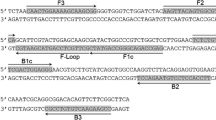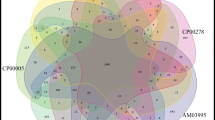Summary
Pseudomonas solanacearum, the causal agent of bacterial wilt, has been classified into three races based on host range and into five biovars based on physiological properties. Strains of race 3 belong exclusively to biovar 2 and primarily affect potatoes. Although this race is thought to have originated in the Andean highlands, it has unusual physiological properties that make it a potential threat to potatoes grown at the cooler latitudes worldwide. Consequently, there is need for a rapid and sensitive method for detection of race 3 strains. We have used subtractive hybridization to enrich for race 3-specific DNA sequences in total race 3 genomic DNA, and thereby obtained a 2 kb clone homologous to DNA from all 28 race 3 strains tested, but with only five of 90 non-race 3 strains. In addition, two larger regions of the genome, containing a minimum of 23 kb of DNA, are also specific for race 3. Deletion of this DNA did not affect virulence. This race 3-specific DNA is a potentially useful diagnostic tool for the detection of race 3 strains.
Similar content being viewed by others
References
Amasino RM (1986) Acceleration of nucleic acid hybridization rate by polyethylene glycol. Anal Biochem 152:304–345
Ausubel FM, Brent R, Kingston RE, Moore DD, Seidman JG, Smith JA, Struhl K (1988) Current Protocols in Molecular Biology. John Wiley and Sons, New York
Barker RH, Suebsaeng L, Rooney W, Alicrim GC, Dourado HV, Wirth DF (1986) Specific DNA probe for the diagnosis of Plasmodium falciparum malaria. Science 231:1434–1436
Boucher CA, Barberis PA, Arlat M (1988) Acridine orange selects for deletion of hrp genes in all races of Pseudomonas solanacearum. Mol Plant-Microbe Interact 1:282–288
Buddenhagen I, Sequeira L, Kelman A (1962) Designation of races in Pseudomonas solanacearum. Phytopathology 52:726
Buddenhagen I (1985) Bacterial wilt revisited. In: Persley GJ (ed) Bacterial Wilt Disease in Asian and the South Pacific, ACIAR Proceedings No 13. ACIAR, Canberra, pp 126–143
Ciampi L, Sequeira L (1980) Influence of temperature on virulence of race 3 strains of Pseudomonas solanacearum. Am Potato J 57:307–317
Cook D, Barlow L, Sequeira L (1989) Genetic diversity of Pseudomonas solanacearum: detection of restriction fragment length polymorphisms with DNA probes that specify virulence and the hypersensitive response. Mol Plant-Microbe Interact 2:113–121
Coplin DL, Cook D (1990) Molecular genetics of extracellular polysaccharide biosynthesis in vascular phytopathogenic bacteria. Mol Plant-Microbe Interact, in press
Harris D (1972) Intra-specific variation in Pseudomonas solanacearum. In: Proceedings of the third international conference of plant pathogenic bacteria, Wageningen pp 289–292
Hayward A (1964) Characteristics of Pseudomonas solanacearum. J Appl Bact 27:265–277
Hendrick CA, Sequeira L (1984) Lipopolysaccharide-defective mutants of the wilt pathogen Pseudomonas solanacearum. Appl Environ Microbiol 48:389–395
Hyman HC, Yogev D, Razin S (1987) DNA probes for detection and identification of Mycoplasma pneumoniae and Mycoplasma genitalium. J Clin Microbiol 25:726–728
Johansen IE, Rasmussen OF, Heide M (1989) Specific identification of Clavibacter michiganense subsp. sepedonicum by DNA-hybridization probes. Phytopathology 79:1019–1023
Kelman A (1954) The relationship of pathogenicity of Pseudomonas solanacearum to colony appearance on a tetrazolium medium. Phytopathology 44:693–695
Kelman A, Hruschka J (1973) The role of motility and aerotaxis in the selective increase of avirulent bacteria in still broth cultures of Pseudomonas solanacearum. J Gen Microbiol 76:177–188
Maniatis T, Fritsch EF, Sambrook J (1982) Molecular Cloning: a laboratory manual. Cold Spring Harbor Laboratory Press, Cold Spring Harbor, New York
Martin C, French ER, Nydegger U (1981) Bacterial wilt of potatoes in the Amazon basin. Plant Disease 65:246–248
Miller JH (1972) Experiments in Molecular Genetics. Cold Spring Harbor Laboratory Press, Cold Spring Harbor, New York
Morton D, Dukes P, Jenkins S (1966) Serological relationships of races 1, 2 and 3 of Pseudomonas solanacearum. Plant Disease Reporter 50:275–277
Olson K (1976) Overwintering of Pseudomonas solanacearum in Sweden. In: Sequeira L, Kelman A (eds) Planning Conference and Workship on the Ecology and Control of Bacterial Wilt Caused by Pseudomonas solanacearum. North Carolina State University, Raleigh, pp 105–109
Seneviratne A (1969) On the occurrence of Pseudomonas solanacearum in the hill country of Ceylon. J Hort Sci 44:393–402
Thurston HD (1963) Bacterial wilt of potatoes in Colombia. Am Potato J 40:381–390
Wood PK, Morrie JG, Small PLC, Sethabutr O, Regina M, Trabulsi L, Kaper JB (1986) Comparison of DNA probes and the Sereny test for identification of invasive Shigella and Escherichia coli strains. J Clin Microbiol 24:498–500
Author information
Authors and Affiliations
Additional information
Communicated by J. Schell
Rights and permissions
About this article
Cite this article
Cook, D., Sequeira, L. The use of subtractive hybridization to obtain a DNA probe specific for Pseudomonas solanacearum race 3. Molec. Gen. Genet. 227, 401–410 (1991). https://doi.org/10.1007/BF00273930
Received:
Issue Date:
DOI: https://doi.org/10.1007/BF00273930




